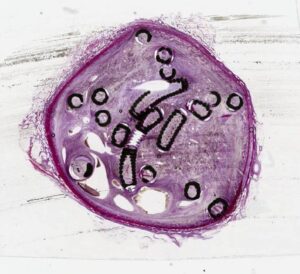ADVERTISEMENT
Study Finds Fibered Embolization Coils Reduce Procedure Times and Radiation Exposure
New York, NY (28 June 2023) — Following the publication of an animal study examining the performance of embolization coils in arteries in the Journal of Vascular and Interventional Radiology (JVIR) in 2019, a second, similar study, published in the May 2023 issue of JVIR, examined fibered and non-fibered embolization coil performance, this time in the venous system.

In this newly published venous ovine study, fibered Nester (Cook Medical) coils and non-fibered coils were deployed in 24 veins in six sheep. The study’s data confirmed that fibered coils demonstrate several advantages over non-fibered coils. These advantages include the following:
- Fibers significantly boosted the immediate occlusive capacity of coils. In the study, fibered coils achieved stasis in 5.3 minutes, while non-fibered coils took nine minutes.
- A significantly lower average radiation dose was required when fibered coils were used: 25.3mGy for fibered coils compared with 34.9mGy for non-fibered coils.
The venous fiber study also substantiated the findings of the earlier arterial fibre study: The two studies found that fewer fibered coils are needed to achieve acute occlusion compared to bare metal coils. Both studies confirmed that significantly less coil length is needed if the coil is fibered.
- In the venous fibre study, on average five fibered coils, or 70cm of fibered coil length, were needed to achieve occlusion compared with 8.75 non-fibered coils, or 122.5cm of bare metal coil length.
- In the arterial fibre study, on average 1.3 fibered coils, or 9.1cm of coil length, were required to achieve occlusion, compared to 3.2 non-fibered coils, or 22.4 cm of non-fibered coil length, that was needed to obtain occlusion.
Should the study results translate to the human experience, patients treated with fibered coils could potentially experience shorter procedure times, require fewer implants and have less radiation exposure to achieve the same outcomes.
In this venous fibre study, a new approach was also applied to generating histologic images. A unique method of cutting 5µm thin sections of tissue with metallic implants was developed by Cook Research Incorporated (CRI) and Alizée Pathology. Thin sectioning results in clearer and more detailed histologic images, allowing a pathologist to read and interpret tissue changes. An image showing a 5µm thick microscope slide of Cook embolization coils in an ovine vein can be seen on the front cover of the May 2023 issue of JVIR.
“When we see in vivo results like this in studies, we hope the same benefits will be applicable to human patients,” said Remco van der Meel, director of product management for Cook’s interventional specialty. “We are constantly evaluating our embolization portfolio, exploring cutting-edge technology and gathering data to create new technology. Additionally we want to understand how we could best support our customers in achieving the best possible outcomes for patients. This study helps us make data-based decisions on how to best meet the needs for effective embolisation in a cost-efficient manner, while reducing exposure to ionizing radiation for both doctor and patient. These are key elements in today’s healthcare environment.”











